Tropical Biology Scouting Trip Reports
Time seems to move in a different dimension here. Hurry drifts into the radiant greens. The mind is quieted by wonder. - Jennifer Ackerman
COSTA RICA July-August 2017
© 2017 Callyn D. Yorke
Link to CURRENT TRIP BIRD LIST Link to Previous Costa Rica scouting trip reports
JOURNAL NOTES
© 2017 Callyn Yorke

Montezuma Oropendola (Psarocolius montezuma) Laguna del Lagarto, Alajuela Costa Rica
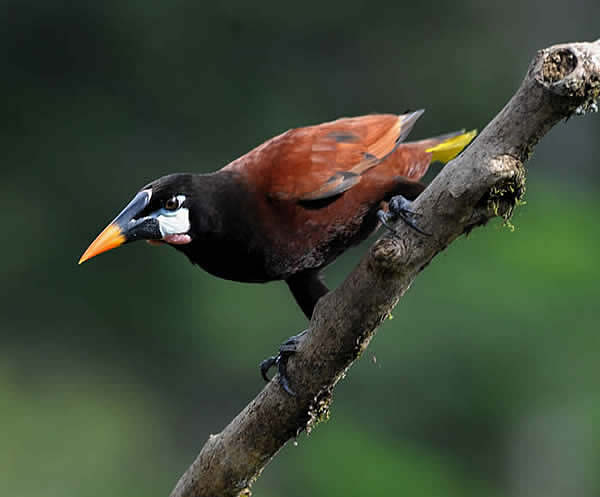
© 2017 Callyn Yorke
INTRODUCTION
Road Map of Costa Rica Approximate scale: 1 inch = 50 mi
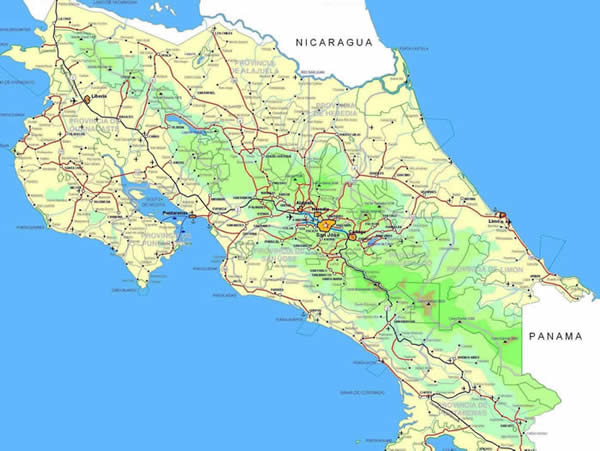
The northern half of Costa Rica, bordering Nicaragua, contains some of the country's most remote and inaccesible terrain, together with stunning scenery and wildlife. My time in this region had in previous years been limited to the rainforests of northeastern Alajuela province, along the San Carlos River, near the village of Boca Tapada. During this visit I wanted to include a bit more of Costa Rica, in particular, Volcan Tenorio National Park, Santa Rosa National Park, the Nicoya Peninsula and Caño Negro National Park.
Admittedly, a long-term natural history study of the San Carlos River area had curtailed my travels in Costa Rica. But it certainly wasn't an unfortunate trade-off. The biodiversity of northeastern Costa Rica is unsurpassed. There is a very real anticipation of encountering new, seldom seen and poorly known species, almost on a daily basis. For a curious field biologist, the place seems to grow on you with each passing day (literally, if you stand in one spot too long). Just learning the relatively common life forms in this region involves countless hours of fieldwork and research. For example, the Boca Tapada (BT) - Laguna del Lagarto (LDL )area bird list is approaching four-hundred species, some of which are largely restricted to this region, such as the Great Green Macaw and Agami Heron. Astonishingly, a Gray-bellied Hawk (Accipiter poliogaster) was photographed near Laguna del Lagarto in late February of this year -- possibly the first record for this species outside of its normal range in northeastern South America. Jaguar, Ocelot and Tapir still roam the large tracts of rain forest. Biologists are using remote camera traps in the Laguna del Lagarto rain forest to document these and other animals that are rare elsewhere in Costa Rica.
July and August are relatively wet months in northeastern Costa Rica; indeed, a day without at least some precipitation was unusual. A kind of suspense, or anticipation of sudden and dramatic change fills the air during such glaringly brilliant days. Thunderhead clouds develop quickly by mid-afternoon. A pressure cooker of heat and humidity builds up to nearly intolerable levels, sparking a distant flash and rumbling. Then, a few moments of breathless silence -- followed by a torrential downpour of such magnitude, umbrellas or windshield wipers at top speed are utterly useless. Cool convection winds bring temporary relief from the heavy tropical air. Birds resume activities within minutes following the rains, quickly harvesting insects, fruits and seeds in preparation for another long, dark, intermittently stormy night. Welcome to the rainy season at Laguna del Lagarto! How could anyone from drought-striken California not absolutely love this place?
Photography continues during the rainy season at Laguna del Lagarto, Boca Tapada Costa Rica July 18, 2017
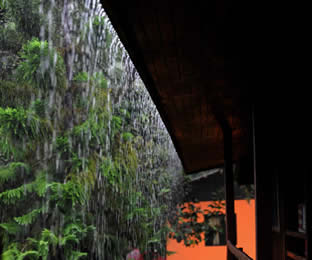
© 2017 Callyn Yorke
Laguna del Lagarto 18 July 2017
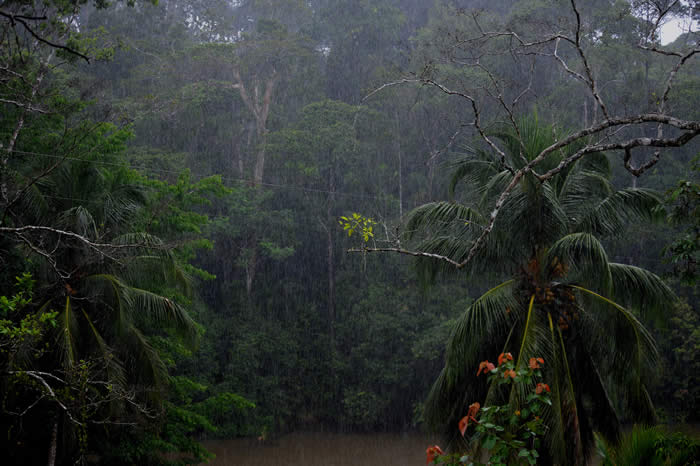
© 2017 Callyn Yorke
Keel-billed Toucan (Rhamphastos sulfuratus) Laguna del Lagarto, 18 July 2017
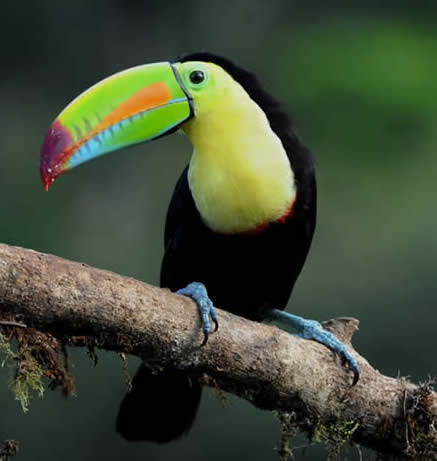
© 2017 Callyn Yorke
A tropical rain forest is full of surprises and always changing. Tree falls due to storms are common (Hurricane Otto hit LDL in late November, 2016, toppling many large trees). The new gaps in the forest let in light, encouraging rapid vegetative growth and primary productivity, attracting many opportunistic, semi-nomadic species. Birds come and go, some on predictable daily and seasonal schedules (e.g. Montezuma Oropendola), others seemingly at random (Orange-chinned Parakeet). In an ecological sense, the two hectares of clearings and gardens at LDL may be utilized by birds and other animals as a natural, relatively large forest gap containing a supermercado of resources in the form of fruiting shrubs, trees and a couple of supplemental banana feeding stations (bananas, native to SE Asia, are readily consumed by a range of organisms, including hymenopterans, guans, curassows, parrots, toucans, honeycreepers, tanagers, oropendolas and coatis).
Each day at Laguna del Lagarto a few more bird species were added to my Annotated Trip List. One particular day with intermittent rain (August 9, 2017), produced fifty-nine bird species, most within sight of the lodge dining area. Not surprisingly, LDL is regularly visited by groups of amateur and professional wildlife photographers, including at least one Hungarian artist, Bence Màté, who has won multiple world competitions in nature photography. As noted in my Trip Advisor review (2012), there is no better place for nature photography in the Neotropics than Laguna del Lagarto.
Strawberry Poison Dart Frog (Dendrobates pumilio) Laguna del Lagarto, Costa Rica 9 August 2017 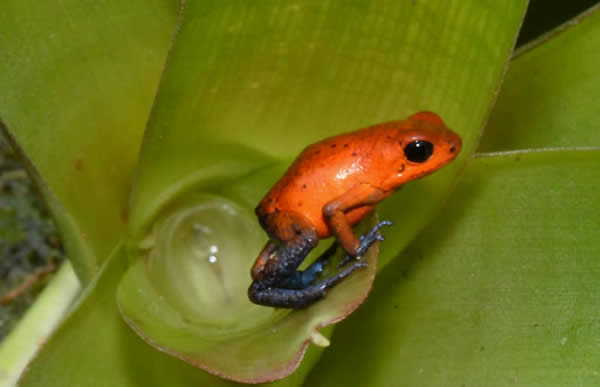
© 2017 Callyn Yorke
Green and Black Poison Dart Frog (Dendrobates auratus) Laguna del Lagarto, Costa Rica 9 Aug. 2017
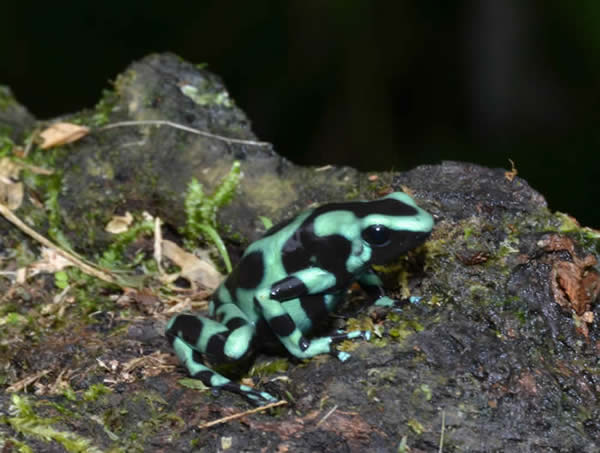
© 2017 Callyn Yorke
Black Myotis (Myotis nigricans) Laguna del Lagarto, Costa Rica 9 August 2017

© 2017 Callyn Yorke
Red-winged Grasshopper (Arphia psuedonietana) Laguna del Lagarto, Costa Rica 9 August 2017

© 2017 Callyn Yorke
One unpleasant and most dreaded surprise occurred during the first week: A terminal camera malfunction. My Nikon D3X and 80-400mm lens, which have produced many quality images over the past decade, often in environmentally challenging conditions, simply refused to work with any consistency. Most likely, moisture had damaged some of the electrical components. Since this occurred in a remote area (LDL), which is at least a four-hour drive to the nearest camera repair shop in San Jose, I was pretty much out of luck. Relying then on a small back-up camera (Nikon D3100 and 19-200 mm lens) and Android cell phone, the remainder of my time in Costa Rica was handicapped by inferior photographic equipment. I suppose this would be equivalent to a long-boarder forced to spend three weeks trying to surf on a boogie board. Nonetheless, I continued my travels, documenting my observations with as much written and illustrated description as possible, making the best of what remained of my functional camera gear. Fortunately, I discovered, largely out of necessity, that the quality of many of the images obtained with the D3100 could be significantly improved by using a Nikon SB 5000 flash unit.
Wherever I found myself in Costa Rica, a delightful assemblage of birds and other interesting natural phenomena magically appeared. Costa Rica, conveniently situated about a day's drive between two oceans of wildly differing temperament and adjacent terrestrial ecoystems, is arguably the best place to study and document the extraordinary diversity of plants and animals in Central America. In short, Costa Rica is a naturalist's paradise.
Slaty-tailed Trogon, fem. (Trogon massena) Laguna del Lagarto Jesus Christ Lizard (Basilicus basilicus) Cano Negro National Park
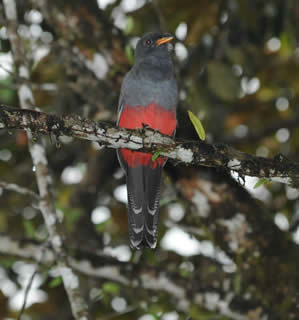
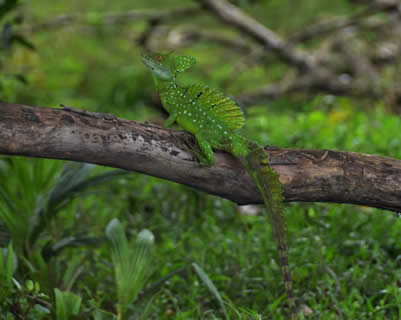
© 2017 Callyn Yorke
Costa Rica Travelogue (July 16- August 13, 2017)
© Callyn Yorke
* July 16-17; August 12-13: Melrost Hotel, Alajuela
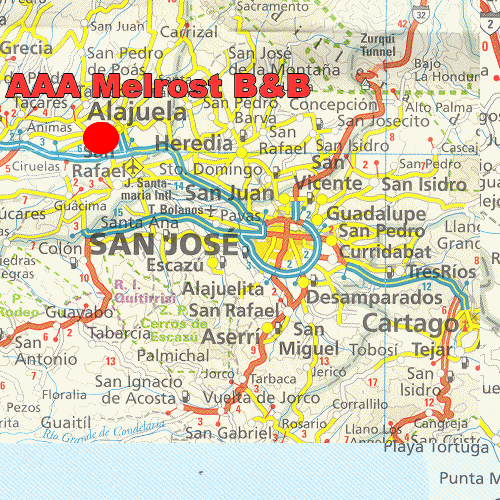
Melrost, a very basic little B&B, is located about ten-minutes by car from the San Jose International Airport. I found it to be convenient, clean, reasonably priced and friendly. The only problem was its organization and efficiency. Melrost advertises a free shuttle van (decorated with an image of a rufous-tailed hummingbird) to the airport. Unfortunately, the hummer shuttle wasn't available for my departing flight Sunday morning, August 13, and the last-minute cab arrangement by the hotel resulted in the nappy-headed driver attempting to drop me with my luggage off on the lower arrival deck instead of the upper departure deck at the airport. I was almost beginning to accept such minor inconveniences when in San Jose: Population 2.2 million, which is 50% of the total population of living in about 4% of the total land area of Costa Rica.
The previous day, when I returned the 4WD Diesel Toyota Fortuner to a nearby National Car Rental yard, I was expecting a free shuttle to the Melrost Hotel (it turns out that National offers a shuttle service only to the airport). I ended up having to pay $15 for a cab, who's driver became lost somewhere in the Alajuela suburbs (few roads in Costa Rica have labeled street signs).
A note to folks considering car rental in Costa Rica: If Costa Rican cab drivers have trouble navigating their streets, a foreign traveler might reasonably expect to become completely lost trying to find a highway out of town. Without GPS (an additional daily rental charge of $5), that would have certainly been true in my case. Also, when renting a car in Costa Rica, after all the additional insurance and related charges, expect the final cost to be about twice the advertised daily rental rate. Notwithstanding a premium insurance package, you may also be required to leave a hefty deposit for potential damages to the car, e.g. $1,500. No worries. When you see wrecked rental cars returning on flatbed trucks, and the wild-west driving conditions immediately outside the rental facility, all of the extra insurance suddenly looks like the only sane option. Pura Vida!
There was decent birding available in the Melrost neighborhood, but I was weary from the six-hour flight (LAX-Guatemala City - San Jose, CR), and four-weeks later on August 12, a brutal five-hour drive back to San Jose. Notable birds I found while stumbling around the hotel garden, included a Hoffmann's Woodpecker, a highly vocal family of Rufous-naped Wren and a very shy Grayish Saltator. A small pasture and a few tall trees adjacent to the hotel may have had more birds than I found; intermittent showers also limited my ability to obtain a reasonably complete bird list for the immediate neighborhood.
* July 18-25; August 8-11: Laguna Del Lagarto (LDL), Loma Lapa Verde, Boca Tapada, Pital, San Carlos River:
Map showing San Carlos River area of norteastern Alajuela Province, Costa Rica
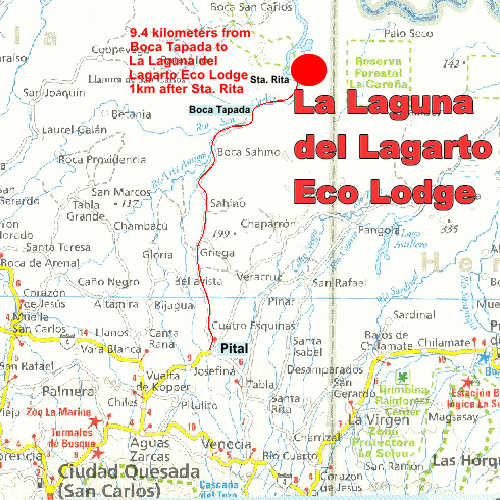
I spent a total of twelve nights at Laguna del Lagarto lodge, divided between two visits, one at the onset of the four-week trip, and a shorter stay at the end. Included within these two time frames were visits to the nearby villages of Santa Rita (e.g. Adolfo's bird photography garden), Boca Tapada (Didier's home and adjacent weedy lots), San Carlos River (Pedacito de Cielo lodge) and the end-of-the-paved road frontier town, Pital. Regional habitats surveyed were, old-growth secondary forest (mostly around LDL and along the road to Boca Tapada, including riverine forest bordering the San Carlos River), pastureland (mostly cattle and horses), agricultual fields (pineapple, banana, taro, assorted vegetable gardens and small farms), grassland, fallow fields, village and town gardens with exotic plantings; roadside second-growth; fresh water marsh, ponds and streams.
Birds were frequently observed and photographed at the LDL banana feeders next to the dining area and in and around the gardens. I also walked the main roadway between LDL and adjacent clearings of Loma Lapa Verde (LLV), including the ponds and second-growth bordering the rain forest. The road between LDL and Boca Tapada offered many birding opportunities, where the unobscured views of the tall rain forest could be easily obtained. Hotspots for birds are in Santa Rita (a small, roadside marsh- good for herons and other waterbirds); Adolfo's garden - especially good for uncommon hummingbirds, and the grassy lots on the south end of Boca Tapada (the only reliable place in the area for the Nicaraguan Seed Finch).
Adolfo Gonzales and his bird photography garden, Santa Rita Scaly-breasted Hummingbird (Phaeochroa cuvierii), Santa Rita
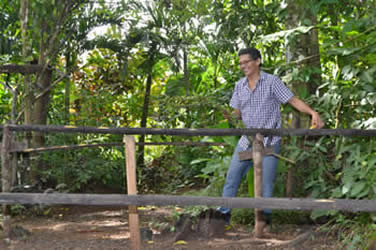
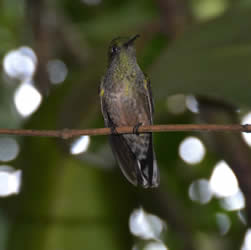
© Callyn Yorke 10 August 2017
LDL lodge with Callyn Yorke and Schmack family, L-R: Vincenz (owner), Karl, Alex and Sebastian 24 July 2017

Bare-throated Tiger Heron (Tigrisoma mexicanum) Santa Rita Nicaraguan Seed Finch (Oryzoborus nuttingi) Boca Tapada

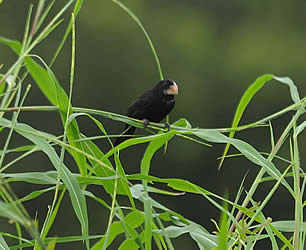
10 August, 2017 © Callyn Yorke 18 July, 2017 © Callyn Yorke
Didier Castro, inspecting the Loma Lapa Verde site for a future field research station -- vicinity of Laguna del Lagarto 19 July 2017
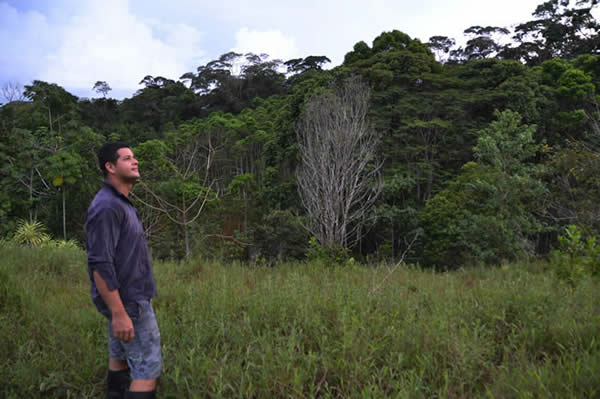
© 2017 Callyn Yorke
My driving route between San Jose and Laguna del Lagarto, included the Inter-American Highway (C1-1) between Alajuela and Naranjo (generally, the largest, fastest highway in the country), HWY 141 between Naranjo and Quesada (a narrow, 2-lane mountain road with many slow trucks), HWY 140 between Quesada and Aguas Zarcas (more of the same), HWY 250 to Pital (partly improved but congested and slow going); Northbound roads from Pital are entirely unpaved, connecting to Boca Tapada and LDL (35 km, riddled with river rock and potholes, but very little traffic). Even with relatively light traffic, the entire route between LDL and San Jose can seldom be driven in less than four hours.
July 26-28: La Carolina Lodge, Parque Nacional Tenorio:
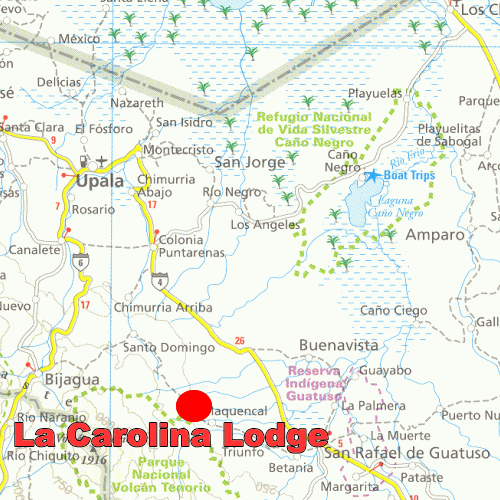
I arrived at the rustic and secluded La Carolina Lodge after a six-hour drive from LDL, mostly on a well-maintained two-lane highway (C-4), but through very heavy, intermittent rain. The last few kilometers to the lodge were on a rough secondary road through foothills and pastureland. The lodge is a working cattle ranch with simple, bungalow-style accomodations. The idyllic setting is within a healthy patch of tall rain forest, alongside a swift-flowing mountain stream. Delicious, home-style meals were prepared from organically farmed produce and livestock (chicken, cattle and pigs), using old-fashioned wood-burning stoves and iron cookware that could have been used in the Bonanza TV series. Even the streamside hot tub (a concrete pool roughly masoned with volcanic river rock) was heated by an antique wood-burning stove.
Considering the remote location of this place, I was surprised to find that the parking area was full of rental cars and only one room (out of about 15) was available, perhaps being saved for Anthony Bourdain. Most of the guests were Europeans and Americans (an American from the Carolinas - no one here could recall which one, North or South - is apparently the absentee owner). Rooms were $70- $90 US per night, cash only. Bienvenidos to the 'low' season in Costa Rica.
Carolina Lodge ranch operations Stream running through the lodge property
© 2017 Callyn Yorke
Anolis sp. (L) and White-tipped Dove (Leptotila verreauxi) Carolina Lodge 26 July 2017
© 2017 Callyn Yorke
Bungalow accomodation at the, Carolina Lodge 26 July 2017
© 2017 Callyn Yorke
Intermittent showers continued throughout the first evening and next day. I had planned to visit nearby Tenorio National Park, but feared sacrificing the remains of my functional camera gear to more water damage. Happily, I secured a room for two more nights and by the third day, the rain subsided. I booked a group tour at CL ($20 pp), led by Alejandro, the poker-faced ranch manager, who seemed to do a little of everything, from shoeing horses to natural history instruction.
Alejandro, Carolina Lodge manager 27 July 2017
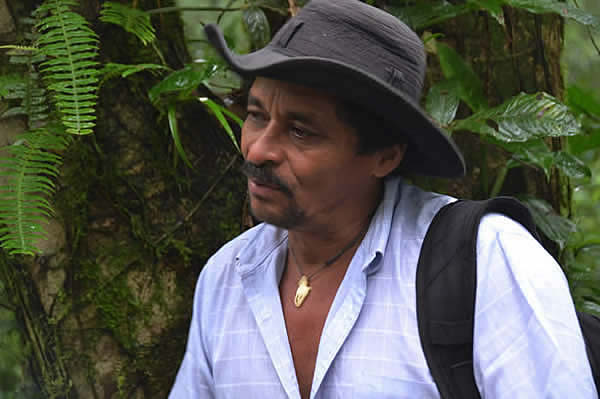
© 2017 Callyn Yorke
Our hiking group consisted of Alejandro, myself, and a Swiss family - husband, wife and three young children. It would be a 45- minute drive on rough roads to the park entrance; Alejandro and I went in my 4WD rental; Swiss family Robinson in theirs. We arrived at the park entrance around 9:45 AM and were guided to a fenced lot, controlled by several parking attendants collecting fees ($2). Alejandro said that in the high season (December-April), more than 2,000 tourists may visit the park every day. The popularity of the park is largely due to the peculiar turquoise-colored streams and pools and water falls caused by aluminum oxides and other volcanic chemicals bubbling to the surface in natural springs. We paid the entry fee ($12), glanced at some maps and information displays, and set off on a 200- m section of paved trail through a dreamy, dripping wet cloud forest.
Entrance sign for Tenorio National Park 26 July 2017
© 2017 Callyn Yorke
Cloud forest trailhead, Tenorio National Park 28 July 2017

© 2017 Callyn Yorke
At first I was skeptical about bringing such young children (aged 5-9 yrs.) on what was turning out to be a rather strenuous march up a slippery mountain trail. But they were happy and energetic, well- mannered, never once whining or complaining like one might experience with typical American children, for the entire five-hour wilderness adventure. Incredible. These three blue-eyed, blonde-haired kids were little angels from heaven. Their enthusiasm was contagious. Even steadfast Alejandro was smiling. This delightful, inquisitive family really earned my admiration. And if that wasn't enough, on the drive back to the lodge, one of the sharp-eyed children spotted a Three-toed Sloth in a small tree along the roadway, which was an absolutely perfect photo opportunity.
Three-toed Sloth (Bradypus tridactylus ) Road to Tenorio N.P. Costa Rica 28 July 2017

© 2017 Callyn Yorke
The mixing of turbid brown and aqua-marine colored waters at various places along the stream, was indeed remarkable. If it wasn't for the fact that the park is a fully protected wilderness, one might suspect the watershed suffered from industrial pollution. Nope. Its a completely natural geological phenomena, and apparently a quite rare one at that. The forest trail along the stream was surreal.
Natural mixing of stream waters in Tenorio National Park 28 July 2017
© 2017 Callyn Yorke
Tenorio National Park 28 July 2017

© 2017 Callyn Yorke
The waterfall, now fenced off due to a recent drowning, was spell-binding as it roared over a 100-foot cliff bordered by mosses, ferns and epiphyte-laden trees. I could see why folks would want to dive into the pool below the falls. It was a paradise to die for. Unfortunately, the force of the falls and great depth of the pool had resulted in a few accidents, so the park service was compelled to strictly enforce a no-swimming rule.
Tenorio National ark 28 July 2017
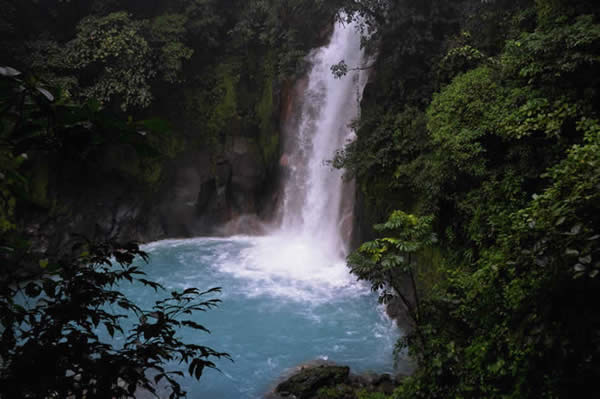
© 2017 Callyn Yorke
July 29-31: Santa Rosa N.P., Canas Castilla (La Cruz), Guanacaste Province

I set off early from Carolina Lodge and retraced my incoming route on an unpaved track, to the intersection of HWY 6, then southward to the small town of Bilagua. This is a gateway for an assortment of adventure tour companies working Tenorio park. Continuing on the well-maintained highway, I soon arrived at the intersection of the Interamerican Highway (C1-1). This is a four-lane, divided highway with a maximum posted speed limit of 110 km/hr. In reality, however, due to frequent speed bumps marking the crossings for villagers, the average speed here,even with light traffic, was about 80 km/hr. Nonetheless, the drive to my first stop, Santa Rosa National Park (good signage on C1-1), was relatively fast by Costa Rican standards.
By the time I arrived at Santa Rosa N.P. it was around 10 AM and warm enough to attract iguanas to the paved roadsides. I had to exercise caution to avoid running over some of them. The park entrance kiosk near C-1, was closed, so I proceeded on the main road through the oak woodland-dry tropical forest to its terminus, a distance of about 7 km. There were a couple of cars in the parking area and an official-looking man motioning to me to enter the adjacent building, a historical landmark (William Walker's bid to takeover Costa Rica ended here), park registration and visitor center. Although the parking area was shaded by a nearly closed canopy of mature trees, I could find no sign of any birdlife - no doubt due to high air temperature (85F) and humidity. Inside the building, I was informed that the park entry fee was $15 for foreigners ($2 for Costa Rican residents). But since I had apparently arrived too late in the day for birding, I left the park rather than pay the fee, planning to return earlier on another day (August 1, 2017).
Santa Rosa National Park Historical Landmark and Visitor Center 29 July 2017
© 2017 Callyn Yorke
Santa Rosa National Park, Tropical Dry Forest research information sign 1 August 2017
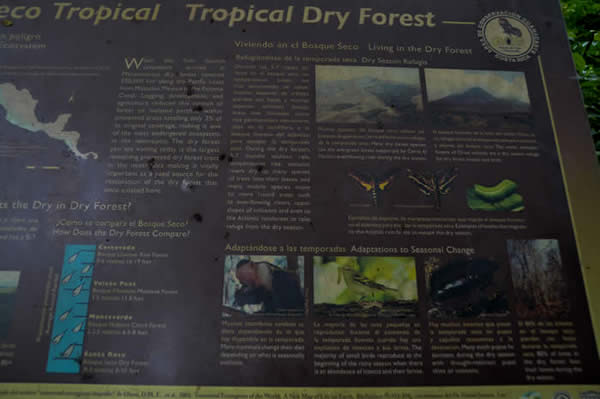
© 2017 Callyn Yorke
Santa Rosa National Park, Guanacaste. Costa Rica viewing northeast 1 August 2017
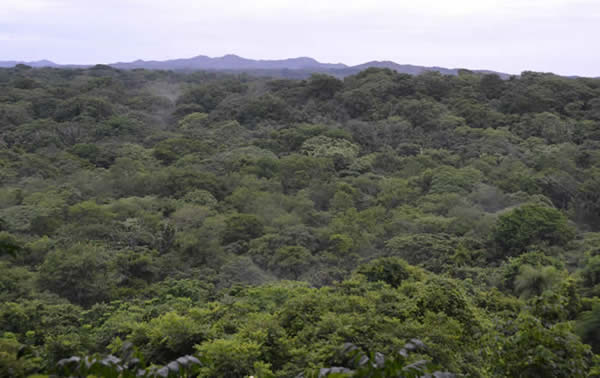
© 2017 Callyn Yorke
Santa Rosa National Park, trail near main campground, 1 August 2017

© 2017 Callyn Yorke
Cream-spotted Tigerwing (Tithoria tarricina) Santa Rosa National Park, Costa Rica 1 Aug. 2017
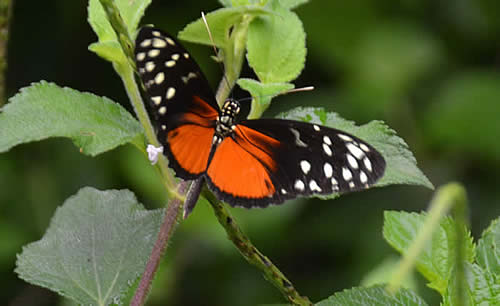
© 2017 Callyn Yorke
Continuing northward and fast approaching the Nicaraguan border, I began watching for highway signs indicating a turn-off for Finca Canas Castilla, mentioned in the Lonely Planet guidebook to Costa Rica.. I found only one small sign, located on C-1 about 5 km north of La Cruz. There was a rather lengthy, muddy road for several more kilometers, passing a couple of villages, crossings of two swift-flowing streams with crumbling concrete bridges, and finally, a modest entryway to the Canas Castilla lodge. This place was definitely off the tour industry radar.
Canas Castilla Lodge entrance, La Cruz, Guanacaste Province Costa Rica 30 July 2017
© 2017 Callyn Yorke
Canas Castilla, La Cruz , Guanacaste 30 July 2017
© 2017 Callyn Yorke
Canas Castilla, La Cruz Guanacaste 30 July 2017
© 2017 Callyn Yorke
Finca Canas Castilla La Cruz, Guanacaste 30 July 2017
© 2017 Callyn Yorke
Bird survey route outside of Canas Castilla La Cruz Guanacaste, Costa Rica 30 July 2017
© 2017 Callyn Yorke
The Resident Ornithologist Canas Castilla, La Cruz Guanacaste 30 July 2017
© 2017 Callyn Yorke
Initially, I had planned to spend only one night at Canas Castilla, then return to Santa Rosa National Park for an early morning bird survey. However, upon arrival I came up with two life-birds (White-throated Magpie Jay and Long-tailed Manakin - two Northwest Costa Rican specialties), and quickly realized I needed to spend more time here.The Swiss owner-manager, Aggie, was very accomodating, giving me a bargain rate on a sweet little bungalow, overlooking a garden and river. Aggie's home-style cooking was gourmet quality, especially the fresh-baked bread. Best of all, the lodge is located within a riverine rain forest and I did not have to venture far to find an assortment of colorful birds, Spider Monkeys and a Two-toed Sloth. In fact, a vocal flock of White-throated Magpie Jay frequented a tree outside my bedroom window.
White-throated Magpie Jay (Calocitta formosa) Canas Castilla, La Cruz Guanacaste, Costa Rica 29 July 2017 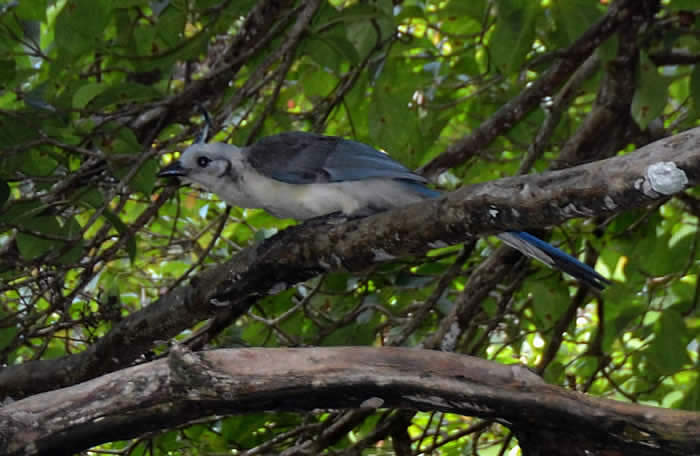
© 2017 Callyn Yorke
The lodge property included signed trails (mostly made by cattle and horses) through pastureland and forest edge; I walked the Red Trail early one morning. The going was awkward, owing to mud and overgrown foliage in places, but did produce a few new birds for my trip list (Yellow-green Vireo, Rufous-capped Warbler and a stray Magnificent Frigatebird gliding high above the hillside). The best birding area, aside from the garden outside the bungalow, was the main access road in front of the lodge. Three separate walks (two of which were during intermittent showers), produced White Ibis, Snowy Egret, Green Kingfisher, Orange-fronted Parakeet (a lifer),and an unidentified tyrranulet. After three days at Canas Castilla, I had identified about thirty-five bird species, which doubtless was less than half of those present in the area. Without question, Canas Castilla should be on every visiting birder's itinerary for northwestern Costa Rica.
August 1 - 7 : Nicoya Peninsula: Playa Tamarindo, Playa Avellana, Samara
Map of Costa Rica showing the location of Playa Tamarindo
Playa Tamarindo Guanacaste, Costa Rica 1 August 2017
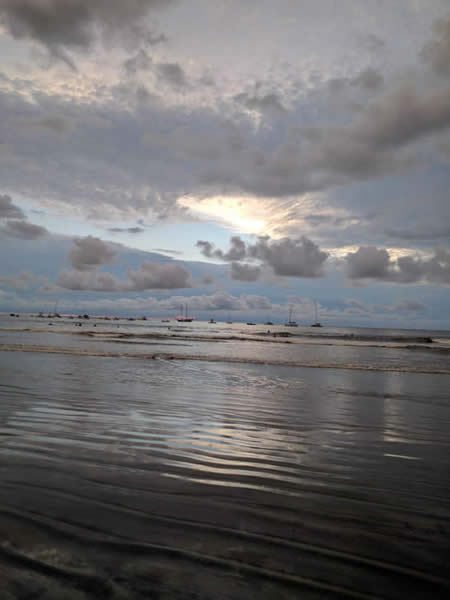
© 2017 Callyn Yorke
The drive from La Cruz to Playa Tamarindo (PT) was fairly easy, using a combination of InterAmerican Highway, and C-155. Traffic around Liberia and the airport was the heaviest; but nothing compared with downtown Playa Tamarindo, which vaguely resembled Laguna Beach, California.
I had contacted Hotel Laumey in PT while at Canas Castilla, and obtained a room reservation for six nights. The owner (Luis), who was on his way back from San Jose, had assigned his 19-year old son Adrian temporary management duties. Adrian greeted me with a big smile when I arrived, handing me a cool drink, while skillfully handling the registration and room assignment details. I was given a spacious, well appointed downstairs room overlooking a pool and garden. The attractive little Oriental garden with mature trees and flowering shrubs, turned out to be a pretty good birding spot. Hotel Laumey was also conveniently located near the shops, restaurants and main beach, yet distant enough to escape the noise and congestion. After a few days at Hotel Laumey, it felt like a place I could have lived for months. Then I visited Samara.
An evening in Playa Tamarindo Costa Rica 3 August 2017 
© 2017 Callyn Yorke
Veined Tree Frog (Trachycephala venulosus) Playa Tamarindo, CR 6 August 2017

© 2017 Callyn Yorke
Playa Tamarindo 3 August 2017
© 2017 Callyn Yorke
Mangrove and Dry Forest tour operations at north end of Playa Tamarindo 2 August 2017
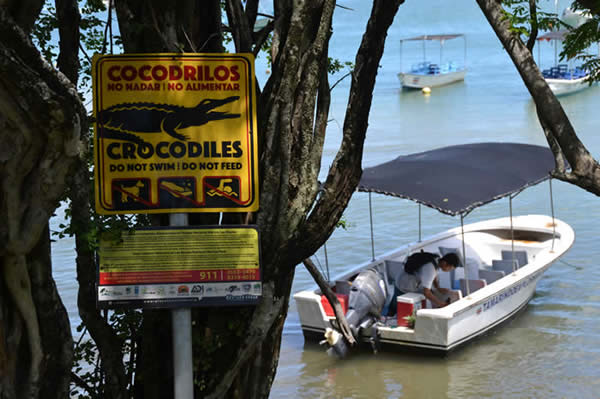
© 2017 Callyn Yorke
Tamarindo Tidal Estuary, Mangrove and Dry Forest 2 August 2017
© 2017 Callyn Yorke
American Crocodile (Crocodylus acutus) Tamarindo Mangrove, Guanacaste Costa Rica 2 August 2017

© 2017 Callyn Yorke
Black-headed Trogon (Trogon melanocephalus) Playa Tamarindo, Costa Rica 6 August 2017 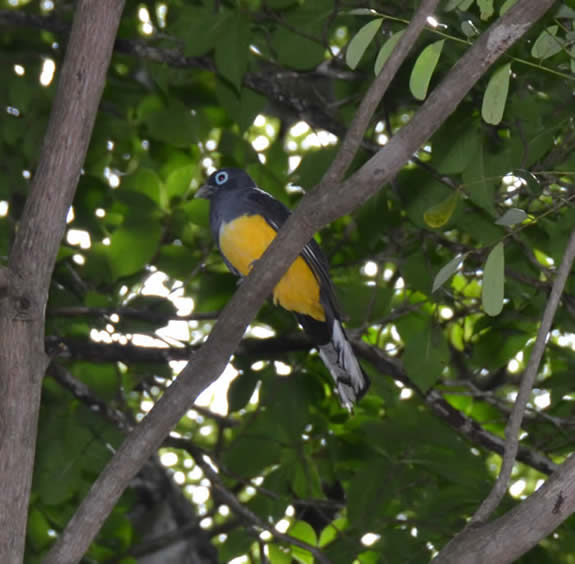
© 2017 Callyn Yorke
Playa Tamarindo was always impacted by heavy traffic, somewhat unexpected for the rainy ('low') season. However, it was a fairly good base camp for exploring the Nicoya Peninsula. There is an extensive ecological preserve of mangrove and tropical dry forest at the north end of town. I participated in an interesting three-hour guided boat and walking tour of that area on the morning of 2 August. The town of Playa Tamarindo everywhere has gardens, patches of forest and second growth attractive to wildlife. I walked most of the streets in the morning and late afternoon, documenting the birdlife. PT ultimately produced birds I did not find anywhere else in Costa Rica during my visit, e.g. Brown Pelican, Mangrove Black Hawk, Tricolored Heron, Green Heron, Yellow-crowned Night Heron, Peregrine Falcon, Willet, Ruddy Turnstone, Canivet's Emerald, Turquoise-browed Motmot, Mangrove Yellow Warbler, Stripe-headed Sparrow and Streak-backed Oriole. For additional amusement, some of the worst roads in Costa Rica going south from PT to Samara, provide access to the rugged, undeveloped coastline of the Nicoya Peninsula..
Willet (Tringa semipalmata) and Whimbrel (Numenius phaeopus) Playa Avellana, Costa Rica 5 Aug. 2017

© 2017 Callyn Yorke
Playa Tamarindo Sanitation Department: Black Vulture (Coragyps atratus) Playa Tamarindo 2 August 2017

© 2017 Callyn Yorke
By contrast with the well-maintained roads connecting Playa Tamarindo with Liberia and towns to the north and east, the unpaved highway along the coast to Samara was a rodeo ride. Recent rains augmented the adventure. It took me nearly the entire day to drive this route (C-160; 150), with two 20-minute stops (Playa Avellana for a little birding and the Playa Negra Cafe -- apparently the only restaurant open along this route during the "low" season) The good news: Very light traffic on this route. The explanation: Out of one pothole and into another for nearly 30 miles. I was mildly surprised my rental Toyota 4WD survived without any damage. Two unmarked stream crossings near Nosara added to the excitement; I had to shut the windows for the second one, where a snorkel would have been useful.
Playa Avellana Guanacaste Costa Rica 5 August 2017
© 2017 Callyn Yorke
Samara, famous for its resident Hollywood celebrities, appeared laid back, almost Jamaican, compared with the frenetic PT, and featured a scenic shore break in a bay flanked by forested hills and an offshore island. Samara had that timeless feel -- the kind of place where days turn into years, where news from abroad carries little relevance to everyday life. Locals and tourists blended together seamlessly. Even the traffic was less hurried than PT. I wondered how long before Samara would begin to resemble Playa Tamarindo. I'm sure the residents of Samara are a bit nervous about its well deserved popularity with tourists.
Frazzled by the drive from PT, I little appetite for anything more than a plate of rice and beans and a hypnotic view of the Samara coastline. All I could think about was why I hadn't booked a hotel in Samara instead of Playa Tamarindo. Back to reality. Soon it would be nightfall and the roads would be really scary. I walked a couple of blocks past a line of small tourist shops and cafes, relunctantly climbing back into my car, promising to return.
Samara Costa Rica 5 August 2017
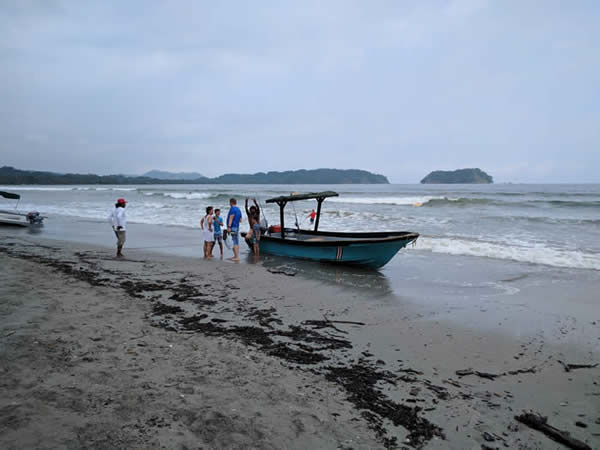
© 2017 Callyn Yorke
August 7-8: Cano Negro, Rio Frio
Map of Costa Rica showing location of Cano Negro National Park (3)
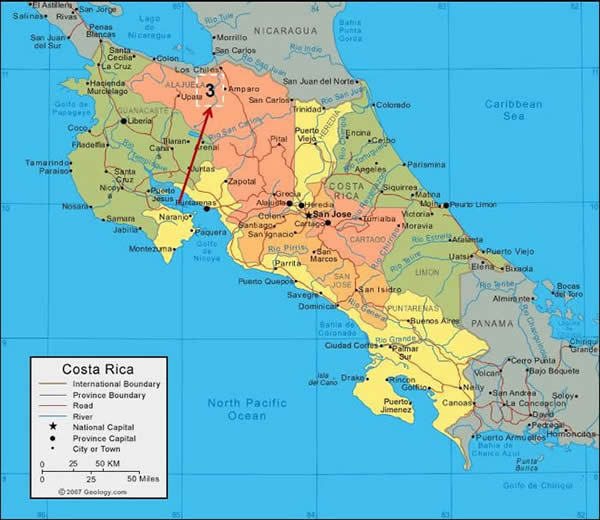
The drive from Playa Tamarindo to Cano Negro was fairly easy in light traffic, but with a couple of unpaved, rough roads (C-4, between Santa Celia and Brasilia; Colonia Puntarenas to Cano Negro; and westward from Cano Negro to Los Chiles), totaling about 40 km. When I arrived at Cano Negro, it was mid-afternoon. I was without reservations, which wasn't a problem at all. It was the very bottom of the low season and some of the hotels were completely closed. Eventually I found The Cano Negro Ecolodge, which was open (barely) and with one Canadian family as their only guests. The resort grounds were spacious had a well kept garden of flowering shrubs and tall trees, interspersed with mowed lawns and a tiled swimming pool. I was given a large, air-conditioned, bungalow-style room, comfortably appointed and shaded by trees. Everything was fine about this place -- location, comfort, helpful staff, food, etc. with one exception. The price: $150 US per night. That was more than twice what I paid for much nicer accomodations in PT. And that was their low season rate.
About 0.3 km from the resort was the edge of a large shallow lake and marsh formed by the Rio Frio. Originating in the Volcan Tenario watershed to the southwest, Rio Frio meanders on a northeasterly course, contributing to a series of wetlands, the deepest and most significant being Laguna Cano Negro. The river continues a few more kilometers to the north, emptying into Lake Nicaragua. Each year (October-February),huge flocks of migratory waterbirds occur at Cano Negro, which is arguably the most important avian wintering grounds in Costa Rica. Local lodges are fully booked at this time (high season room rates), catering to crowds of birders from Europe and America.
A couple of sharp left and right turns on a muddy road from the lodge, ended at a vacant government kiosk marking the entrance to Cano Negro National Park. An aluminum framed boat dock extended out into open water. Nearby, a tree line levee leading to a covered observation deck overlooking the marsh and Rio Frio. I wandered around the area for about thirty minutes before being approached by a tour operator, Marlon, whom was more than willing to take me out in his covered, 20- passenger, fiberglass boat in search of birds the following morning at 0600 hrs.. His fee for a 2-hour boat trip: $40, which was certainly reasonable, since I would be the only passenger.
Marlon was right on time the next morning and we set off down the Rio Frio. The banks of the river were mostly inundated by relatively high water, with lush, overhanging vegetation typical of riverine rain forest in this region. Soon, we encountered Ringed and Amazon Kingfishers, Kiskadee Flycatchers, and a number of other fairly common bird species in or near the tall, riverine forest. Marlon called out the common names of the birds in broken English, which took me some time to decipher. Generally, he knew most of the large, conspicuous birds. Smaller birds flitting about in the trees along the river seldom earned his attention.
The current was fairly swift (3-5 km/hr) which hampered attempts to hold the boat still while I positioned myself for photos. This was when I really missed my big camera and long lens, having to get by with a 19-200 mm lens and a fairly low-end camera with low megapixel resolution and a slow processor chip. Nevertheless, Marlon did his best to get as close as possible to the subjects, and I managed to obtain a few identifiable images, e.g. Snail Kite and Sungrebe -- the latter was a life bird for me.
.
Cano Negro National Park entrance, Costa Rica 7 August 2017
© 2017 Callyn Yorke
Marlon with his Cano Negro - Rio Frio tour boat 8 August 2017
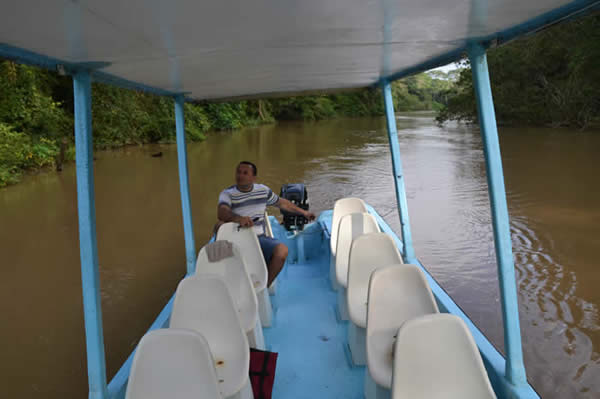
© 2017 Callyn Yorke
Rio Frio Cano Negro Costa Rica 8 August 2017
© 2017 Callyn Yorke
Snail Kite (Rostrhamus sociabilis) Rio Frio Cano Negro Costa Rica 8 Aug 2017
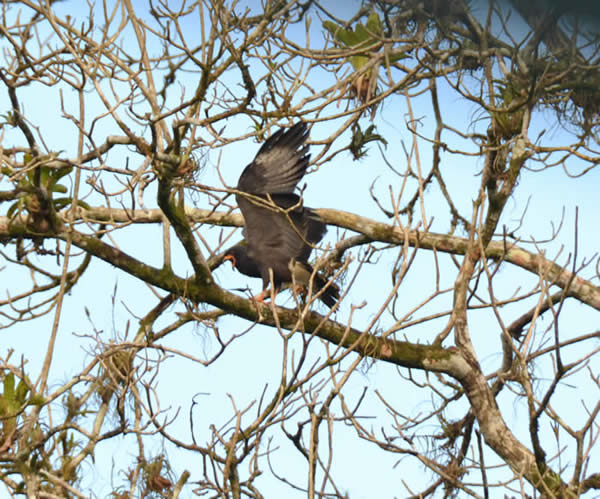
© 2017 Callyn Yorke
Sungrebe (Heliornis fulica) Rio Frio, Cano Negro Costa Rica 8 August 2017
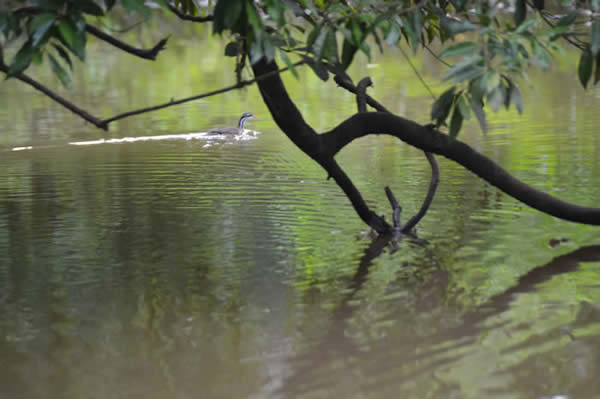
© 2017 Callyn York
Guapote cichlid (Parachromis managuensis) caught by a fisherman in Cano Negro 7 August 2017
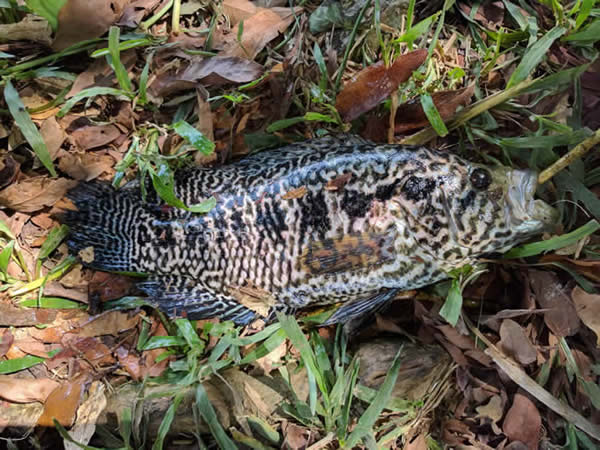
© 2017 Callyn Yorke
Barred Antshrike (Thamnophilus doliatus) Cano Negro, Costa Rica 7 August 2017
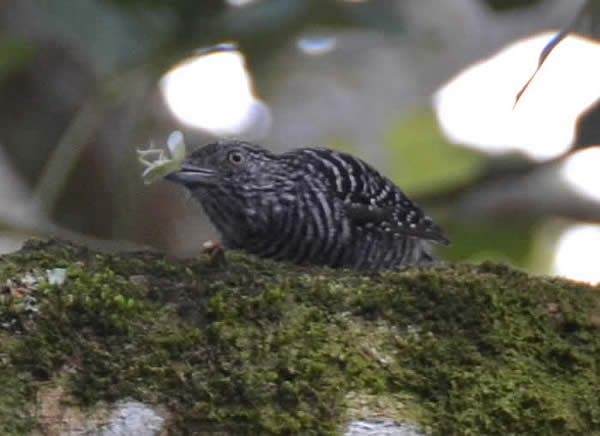
© 2017 Callyn Yorke
Laguna Cano Negro Costa Rica 8 August 2017

© 2017 Callyn Yorke